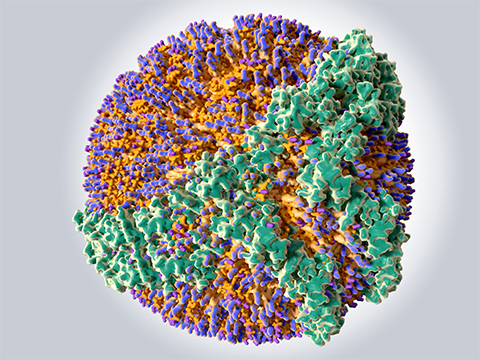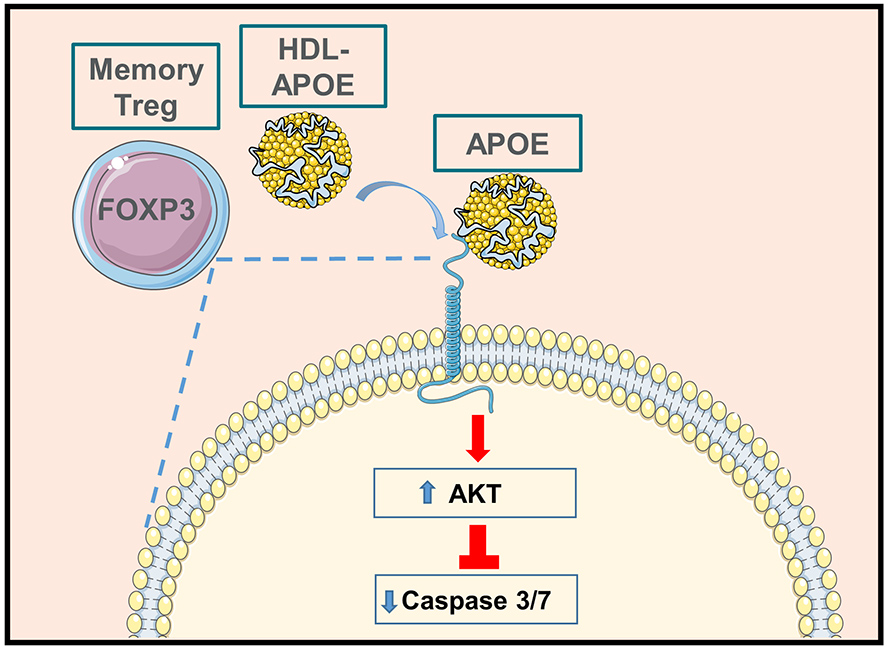There’s more than one way to be good
If you’ve had a blood test to check your cholesterol levels, your doctor probably told you both your so-called good, or high-density lipoprotein, and bad, or low-density lipoprotein, cholesterol levels. HDL is known for helping your body get rid of LDL, and this is great for your cardiovascular system; LDL is a component of atherosclerotic plaques that build up in arteries and lead to heart attacks.
However, researchers have begun to see that story as incomplete. Several groups at Cincinnati Children’s Hospital Medical Center and the University of Cincinnati College of Medicine working together recently published a study in the Journal of Lipid Research showing one way that HDL does much more than remove LDL.

Claire Chougnet is the lead author on the study “It has become clearer and clearer to the field that HDL is acting through other mechanisms,” she said, “particularly through immune modulating capacity.”
That the immune system influences cholesterol and health isn’t news. In fact, macrophages taking up LDL is one of the first steps down the path to developing atherosclerotic plaques in the arteries.
Macrophages are part of the innate immune system, however, and Chougnet and her group were interested in the other arm, the adaptive immune system, which has a less clear role in metabolic disease.
Laura Atehortua is the first author on the paper. “It is well known that innate immune cells recognize HDL,” she said, “so we wondered what is going to happen with adaptive immune response.”
Using human samples from blood banks, which requires meticulously repeating the experiments many times to account for the inherent variability in the samples, the researchers found that HDL can prevent cell death in T regulatory cells, or Tregs, a type of CD4+ T lymphocytes that are responsible for resolving inflammation.
Atehortua explained the role of Tregs. “They’re very important for immune system,” she said. “They’re the ones that say ‘oh it's enough.’”

Researchers have shown that the number of Tregs, which is regulated by the balance between Treg proliferation and Treg death, influences the overall level of inflammation in the body, which in turn influences atherosclerosis, metabolic diseases and other conditions including autoimmune diseases.
Once they found that HDL prevented Treg death, but not that of other CD4+ T lymphocytes, the researchers wanted to figure out what exactly in the HDL was having this effect, and they expected lipids to be the key. However, using reconstituted HDL particles lacking various components, they found that it wasn’t the lipid, but the proteins in the HDL particles that acted on Tregs to prevent their death.
“This was not at all what we expected,” Chougnet said. “The first surprise was that it was not the lipid but the protein, and the second surprise was that in the protein, it was a relatively minor protein not the major protein.”
The researchers found the prosurvival effect was mediated by apolipoprotein E, a protein found less abundantly on HDL than the more common apolipoprotein A.
This work may help scientists design better treatments for cardiovascular and metabolic diseases, as it highlights a potential point of intervention to reduce systemic inflammation.
Enjoy reading ASBMB Today?
Become a member to receive the print edition four times a year and the digital edition monthly.
Learn moreGet the latest from ASBMB Today
Enter your email address, and we’ll send you a weekly email with recent articles, interviews and more.
Latest in Science
Science highlights or most popular articles

Bacteriophage protein could make queso fresco safer
Researchers characterized the structure and function of PlyP100, a bacteriophage protein that shows promise as a food-safe antimicrobial for preventing Listeria monocytogenes growth in fresh cheeses.

Building the blueprint to block HIV
Wesley Sundquist will present his work on the HIV capsid and revolutionary drug, Lenacapavir, at the ASBMB Annual Meeting, March 7–10, in Maryland.

Gut microbes hijack cancer pathway in high-fat diets
Researchers at the Feinstein Institutes for Medical Research found that a high-fat diet increases ammonia-producing bacteria in the gut microbiome of mice, which in turn disrupts TGF-β signaling and promotes colorectal cancer.

Mapping fentanyl’s cellular footprint
Using a new imaging method, researchers at State University of New York at Buffalo traced fentanyl’s effects inside brain immune cells, revealing how the drug alters lipid droplets, pointing to new paths for addiction diagnostics.

Designing life’s building blocks with AI
Tanja Kortemme, a professor at the University of California, San Francisco, will discuss her research using computational biology to engineer proteins at the 2026 ASBMB Annual Meeting.

Cholesterol as a novel biomarker for Fragile X syndrome
Researchers in Quebec identified lower levels of a brain cholesterol metabolite, 24-hydroxycholesterol, in patients with fragile X syndrome, a finding that could provide a simple blood-based biomarker for understanding and managing the condition.

